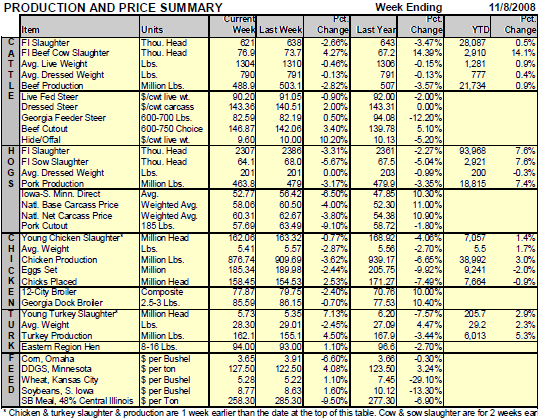



CME: Proposition 2 Not So Dumb After All
US - CME's Daily Livestock Report for 7th November 2008.Steve Meyer writes: Well, California’s Proposition 2 is not as dumb as we portrayed it to be in Thursday’s DLR. A closer perusal of the ballot initiative (sparked again by a reader!) in the link we provided indicates that the only “covered animal” is “pig during pregnancy, calf raised for veal or egg-laying hen.” Once a sow has farrowed (ie. given birth), she is obviously no longer pregnant so it appears she can then be kept in an individual stall that does not meet the Prop 2 criteria of allowing animals to lie down, stand up, fully extend all limbs without touching its enclosure or another animal and turning around freely. So, farrowing stalls are still allowed.
There is still a lack of clarity in the wording, though, and it is an important one. Just when is the sow considered pregnant? The date she is bred or when that pregnancy is confirmed using ultrasound? It’s an important question. Most producers who are moving to group housing for sows, including Smithfield Foods, plan to place sows in individual pens after weaning and through 30-35 days post-breeding. This practice prevents fighting by sows placed into new social groups at a time when their body condition has been somewhat depleted due to lactation. It also allows embryo implantation before the stress of putting groups together, leading to a larger subsequent litter. This “breeding stall” practice can help producers achieve productivity levels near those of farms that use individual housing for sows all the way through gestation. The voluntary agreement made by Colorado producers to phase out gestation stalls specifically allows these breeding stalls.
The unusually large year-on-year reductions of egg sets that began the week of September 20 are now impacting broiler chick placements. Placements for the week that ended October 18 were 11.6% lower that one year ago — the largest such decline in our database that dates back to 1987. Placements for the week of October 25 (shown in the table at left) were down 7.5% from last year and the average decline for the past four weeks (which coincides to eggs sets beginning the week of September 20) have been 6.7% lower than during the same time in 2007.
Do not allow the 10% increases in broiler prices fool you — things are still not that good in the chicken market. It’s just that this year’s prices in the high $70s and $80s are far better than last year’s which plunged roughly $10 during the month of September.
The reductions in sets and placements have yet to impact the chicken market but should soon. Eggs have a 21-day incubation period and then broilers are grown about 5-7 weeks, depending on the desired weight of the birds, before they are harvested. The sets of the week of September 20 should reach the lighter market weights this week or next. Higher average weights will reduce the cutbacks’ impacts to some degree but lower chicken supplies should be supportive to all of the meat sectors.










